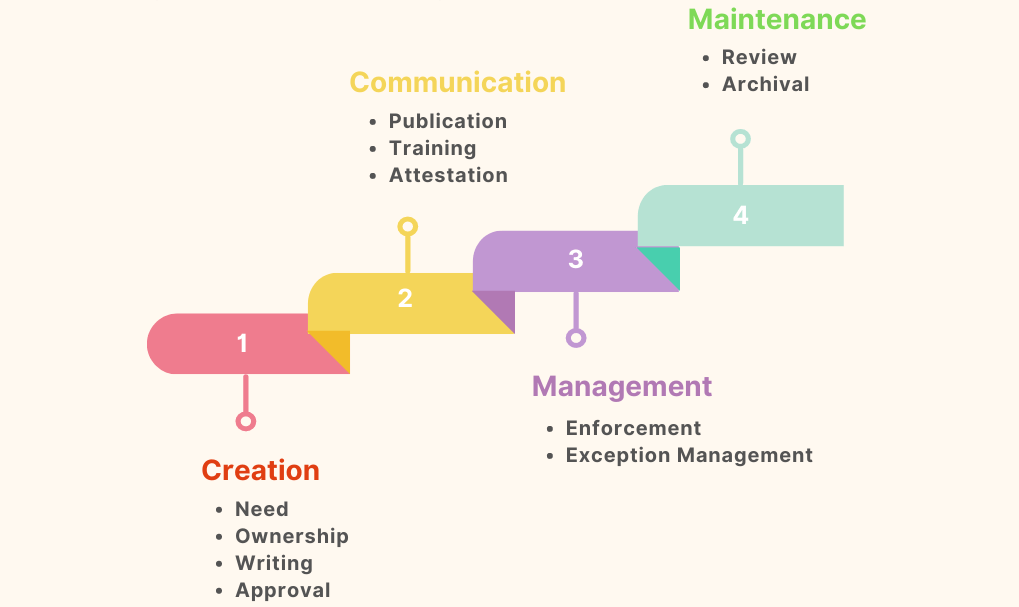- Email: info@clearinfosec.com
- 1800 760 5656

Reports say that addressing uncertainties is the condition that most organizations aren’t prepared for. But with a Governance, Risk, and Compliance program, it is easier to predict and address uncertainties and act with integrity. The GRC program is created to predict the risks, get prepared for them and protect yourselves from litigation. Over time, organizations will be able to achieve their objectives efficiently.
An Efficient and effective GRC program should be built from a comprehensive policy management system. Making a set of policies and just announcing their existence isn’t a Policy management system. The rapidly changing regulatory standards of today can be met only with properly aligned policies that keep everything in line. It should be able to adjust and adapt to the needs of the organization.
Regardless of whether a company is just a start-up or a well-established enterprise, the need of understanding and maintain an effective policy lifecycle management is important. In this context, let us look into what a policy really is and its lifecycle.
What are Policies
Policies establish limits for how people, systems, and business connections should behave. The Code of Conduct, which outlines principles and values that apply to the entire organization, serves as the foundation for all other policies. Policies include behaviour expectations so that people are aware of what is expected of them and not. Policies should define the corporate culture and boundaries of individual and business behaviour and personal conduct.
Why are policies important
It is through the policies we define, communicate, and articulate the boundaries, practices, and expectations of an organization. An organization cannot have a strong and established culture without the presence of a good policy in place. With policies managed correctly, exceptions to the policies can be governed efficiently and violations can be recognized and responded to it right on time.
Without the presence of strong policies, organizations quickly become something they never intended. But with good policies governing the culture and objectives, the corporate culture never goes on unintended paths.
According to The GRC Pundit, “Policies, done right, articulate and build the desired corporate culture and drive standards for individual and business conduct”.
Phases of policy management lifecycle
An effective policy management system follows a lifecycle for the policies. This helps in separating the ineffective policies, out of date, and not aligned with the business needs. The lifecycle is defined under the below phases:

Creation:
Policies are created for a variety of reasons, to meet compliance, fulfill business partner obligations, ensure best practices, instill corporate values, etc. so the first step involved in creating a policy would be Defining the need. Once the need is defined, organizations can Decide on the ownership of the policies to be created. The people with roles assigned as owners should take the responsibility of implementing the policies and monitoring them. Then comes the Policy Writing stage. The policy should be defined more clearly, easy to understand, and ideally consistent in the format, and language. Once written, the policy should undergo an Approval stage. This should be done by the persons with the respective roles assigned before going into circulation.
Communication:
According to GRC pundit, this phase should contain 3 sub-phases including Publication, Training, and attestation. Organizations should publish the policies with at least a single authoritative source. Without the right authoritative source, the policy would become difficult to manage in the long run, and the chances of more policies becoming out-of-date. A policy management software in place can efficiently avoid this problem. It allows the right persons with the right roles can login and manage all the existing policies. Training is crucial because companies need to be able to prove that employees are aware of policies and what is expected of them. Once the individuals have read the policy and taken the associated training, the next is to track the attestation of the policy, and that they will adhere to it.
Management:
This phase includes the monitoring of policies in the ongoing processes. Every instance of non-compliance and policy violation should be recorded, and it should be considered when the policy review comes up. Although policies must be followed, there are several situations where the organization tolerates non-compliance. These exceptions are also supposed to be documented and managed.
Maintenance:
This is the final phase. The policies should be reviewed at regular intervals. If it is still found effective at the time of review, the policy is approved again for the individuals to follow and if found inefficient, that policy should be marked retired or moved to the archive so that it is still available for reference in the future.
How a policy management application can be effective, efficient, and agile
an ineffective approach to defining policy management can leave a business open to risks and vulnerable to liability. How do you know whether what you are doing is right or wrong? The solution is Clear Infosec’s ClearGRC.
It is a complete IT GRC tool with tools and modules that helps you to Govern your organization, manage assets, Risks, and compliance, assess yourself for a wide range of compliances and third-party risks, and much more. It enables you to control your organization’s Policies and Procedures lifecycle and thus ensures effective governance and full compliance. That means, yes, less risk.
Reach out to know more about ClearGRC and schedule a demo.
Copyright © 2024 Clear Infosec. All Rights Reserved.
54 Comments
Comments are closed.